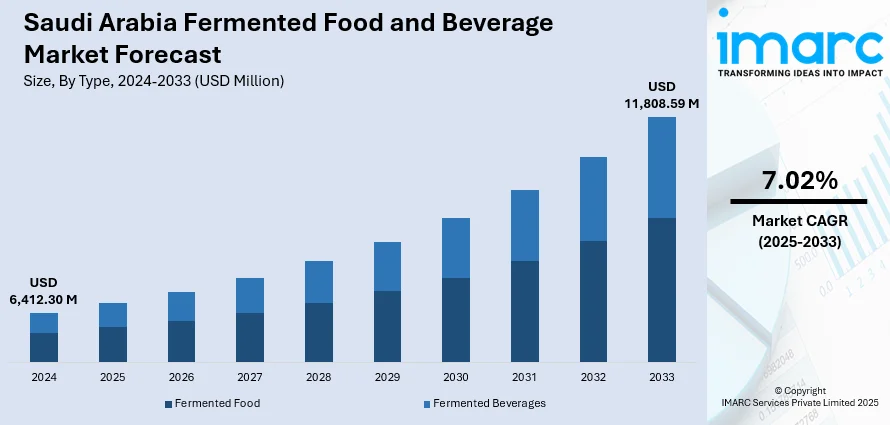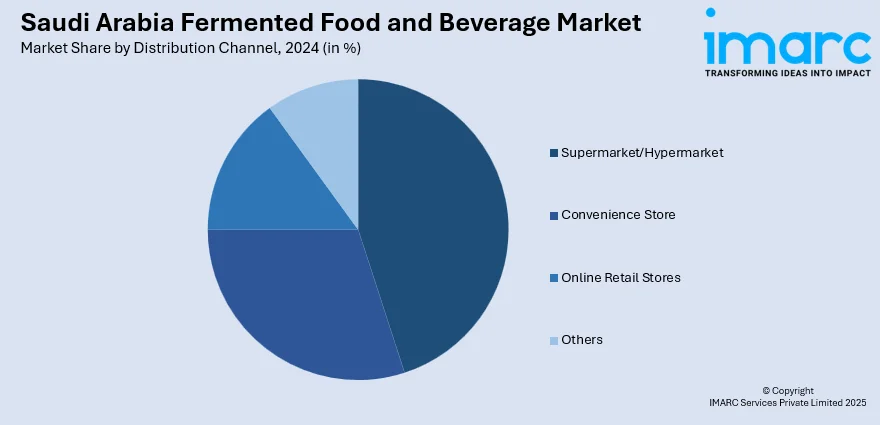
Saudi Arabia Fermented Food and Beverage Market Size, Share, Trends and Forecast by Type, Distribution Channel, and Region, 2025-2033
Saudi Arabia Fermented Food and Beverage Market Overview:
The Saudi Arabia fermented food and beverage market size reached USD 6,412.30 Million in 2024. Looking forward, IMARC Group expects the market to reach USD 11,808.59 Million by 2033, exhibiting a growth rate (CAGR) of 7.02% during 2025-2033. The market is driven by rising health consciousness and consumer preference for probiotic-rich foods that aid digestion and immunity. Urban lifestyles and demand for convenient, functional products are expanding the reach of fermented dairy products, thereby fueling the market. Government-backed food manufacturing initiatives are promoting domestic production and innovation, further augmenting the Saudi Arabia fermented food and beverage market share.
|
Report Attribute
|
Key Statistics
|
|---|---|
|
Base Year
|
2024
|
|
Forecast Years
|
2025-2033
|
|
Historical Years
|
2019-2024
|
| Market Size in 2024 | USD 6,412.30 Million |
| Market Forecast in 2033 | USD 11,808.59 Million |
| Market Growth Rate 2025-2033 | 7.02% |
Saudi Arabia Fermented Food and Beverage Market Trends:
Rising Health Awareness and Functional Nutrition Demand
Saudi consumers are increasingly adopting health-focused diets that emphasize digestive well-being, immunity enhancement, and natural nutrition. Fermented foods, known for their probiotic content and gut-health benefits, align with this growing preference for functional foods. Yogurt, laban (fermented milk), kefir, and fermented pickles are gaining wider acceptance, especially among younger and urban consumers who are seeking natural, nutrient-rich options. Additionally, health education campaigns and greater access to nutritional information have increased awareness of how gut microbiota supports immune health, weight management, and chronic disease prevention. A recent study led by King Abdulaziz University in collaboration with RCSI University and supported by Mara Renewables Corporation, which leverages advanced microalgae fermentation, demonstrated the effectiveness of omega-3 DHA-enriched foods in improving public health in Saudi Arabia. The study involved 80 healthy adults and showed that consumption of DHA-enriched chicken and eggs resulted in a 0.9% higher red cell Omega-3 Index, with the number of participants in the very high-risk category (<4% Omega-3 Index) being reduced by more than half. Additionally, the number of participants with a protective Omega-3 Index (>6%) increased four-fold, proving the potential of microalgae fermentation-based omega-3 DHA to address widespread nutritional deficiencies. Supermarkets and health food retailers now stock an expanded range of fermented products, often featuring functional claims related to digestion, immunity, and low sugar content. The incorporation of fermented beverages and dairy alternatives into mainstream diets illustrates a broadening consumption base beyond traditional use. Local producers are also innovating with low-fat and fortified versions to meet changing preferences. This convergence of health priorities and accessible product offerings is accelerating Saudi Arabia fermented food and beverage market growth, supported by shifting lifestyle dynamics and increasing awareness of food-based wellness.

Government Support for Food Security and Domestic Processing
Saudi Arabia’s Vision 2030 includes targeted investment in domestic food manufacturing to enhance self-sufficiency and reduce dependency on imports. Fermented foods and beverages, with their long shelf life and natural preservation qualities, are a strategic fit within this framework. The government is encouraging local food processing capabilities through financial incentives, subsidies, and industrial zone development, which helps stimulate production of fermented dairy, vegetables, and beverages. These efforts are aligned with national food security goals that prioritize scalable, sustainable, and culturally relevant food categories. Local dairy producers are receiving policy and infrastructure support to expand capacity and introduce value-added products such as fortified laban, cultured milk, and probiotic-rich drinks. In addition, rising interest in Halal-certified and locally sourced health foods has pushed both domestic and multinational brands to innovate within the fermented category. On March 28, 2023, Unibio International PLC announced a significant investment agreement with the Saudi Industrial Investment Group (SIIG), securing approximately USD 70 million to expand its sustainable protein production capabilities. This funding will enable Unibio to scale its unique U-Loop® fermentation technology, which uses methane as feedstock to produce Uniprotein®, a high-quality protein suitable for animal and fish feed. Uniprotein®, already approved for feed use in the European Union, is poised to contribute to food security by providing a sustainable protein alternative. These regulatory and policy-driven developments enable broader access to high-quality, locally processed fermented items. The emphasis on manufacturing innovation, food resilience, and value-added product lines ensures the market’s alignment with long-term strategic objectives.
Saudi Arabia Fermented Food and Beverage Market Segmentation:
IMARC Group provides an analysis of the key trends in each segment of the market, along with forecasts at the country and regional levels for 2025-2033. Our report has categorized the market based on type and distribution channel.
Type Insights:
- Fermented Food
- Yogurt
- Tofu
- Tempeh
- Sauerkraut/Fermented Veggies and Pickles
- Cheese
- Others
- Fermented Beverages
- Yogurt Drinks/Smoothies
- Kombucha
- Kefir
- Others
The report has provided a detailed breakup and analysis of the market based on the type. This includes fermented food (yogurt, tofu, tempeh, sauerkraut/fermented veggies and pickles, cheese, and others) and fermented beverages (yogurt drinks/smoothies, kombucha, kefir, and others).
Distribution Channel Insights:

- Supermarket/Hypermarket
- Convenience Store
- Online Retail Stores
- Others
The report has provided a detailed breakup and analysis of the market based on the distribution channel. This includes supermarket/hypermarket, convenience store, online retail stores, and others.
Regional Insights:
- Northern and Central Region
- Western Region
- Eastern Region
- Southern Region
The report has also provided a comprehensive analysis of all major regional markets. This includes Northern and Central Region, Western Region, Eastern Region, and Southern Region.
Competitive Landscape:
The market research report has also provided a comprehensive analysis of the competitive landscape. Competitive analysis such as market structure, key player positioning, top winning strategies, competitive dashboard, and company evaluation quadrant has been covered in the report. Also, detailed profiles of all major companies have been provided.
Saudi Arabia Fermented Food and Beverage Market News:
- On February 3, 2025, Liberation Labs, a US-based biotech firm, raised USD 50.5 million in funding to develop precision fermentation factories in the US and Saudi Arabia. The company will use the latest capital injection to design and develop plans for a commercial-scale precision fermentation facility in Saudi Arabia, a nation actively pursuing future-friendly foods and net-zero goals. Saudi Arabia has partnered with local food companies to develop alternative proteins, and NEOM, the country’s future-focused city, is backing innovative food companies like Topian, which aims to enhance food security and sustainability.
Saudi Arabia Fermented Food and Beverage Market Report Coverage:
| Report Features | Details |
|---|---|
| Base Year of the Analysis | 2024 |
| Historical Period | 2019-2024 |
| Forecast Period | 2025-2033 |
| Units | Million USD |
| Scope of the Report |
Exploration of Historical Trends and Market Outlook, Industry Catalysts and Challenges, Segment-Wise Historical and Future Market Assessment:
|
| Types Covered |
|
| Distribution Channels Covered | Supermarket/Hypermarket, Convenience Store, Online Retail Stores, Others |
| Regions Covered | Northern and Central Region, Western Region, Eastern Region, Southern Region |
| Customization Scope | 10% Free Customization |
| Post-Sale Analyst Support | 10-12 Weeks |
| Delivery Format | PDF and Excel through Email (We can also provide the editable version of the report in PPT/Word format on special request) |
Key Questions Answered in This Report:
- How has the Saudi Arabia fermented food and beverage market performed so far and how will it perform in the coming years?
- What is the breakup of the Saudi Arabia fermented food and beverage market on the basis of type?
- • What is the breakup of the Saudi Arabia fermented food and beverage market on the basis of distribution channel?
- What is the breakup of the Saudi Arabia fermented food and beverage market on the basis of region?
- What are the various stages in the value chain of the Saudi Arabia fermented food and beverage market?
- What are the key driving factors and challenges in the Saudi Arabia fermented food and beverage market?
- What is the structure of the Saudi Arabia fermented food and beverage market and who are the key players?
- What is the degree of competition in the Saudi Arabia fermented food and beverage market?
Key Benefits for Stakeholders:
- IMARC’s industry report offers a comprehensive quantitative analysis of various market segments, historical and current market trends, market forecasts, and dynamics of the Saudi Arabia fermented food and beverage market from 2019-2033.
- The research report provides the latest information on the market drivers, challenges, and opportunities in the Saudi Arabia fermented food and beverage market.
- Porter's five forces analysis assist stakeholders in assessing the impact of new entrants, competitive rivalry, supplier power, buyer power, and the threat of substitution. It helps stakeholders to analyze the level of competition within the Saudi Arabia fermented food and beverage industry and its attractiveness.
- Competitive landscape allows stakeholders to understand their competitive environment and provides an insight into the current positions of key players in the market.
Need more help?
- Speak to our experienced analysts for insights on the current market scenarios.
- Include additional segments and countries to customize the report as per your requirement.
- Gain an unparalleled competitive advantage in your domain by understanding how to utilize the report and positively impacting your operations and revenue.
- For further assistance, please connect with our analysts.
 Request Customization
Request Customization
 Speak to an Analyst
Speak to an Analyst
 Request Brochure
Request Brochure
 Inquire Before Buying
Inquire Before Buying




.webp)




.webp)












